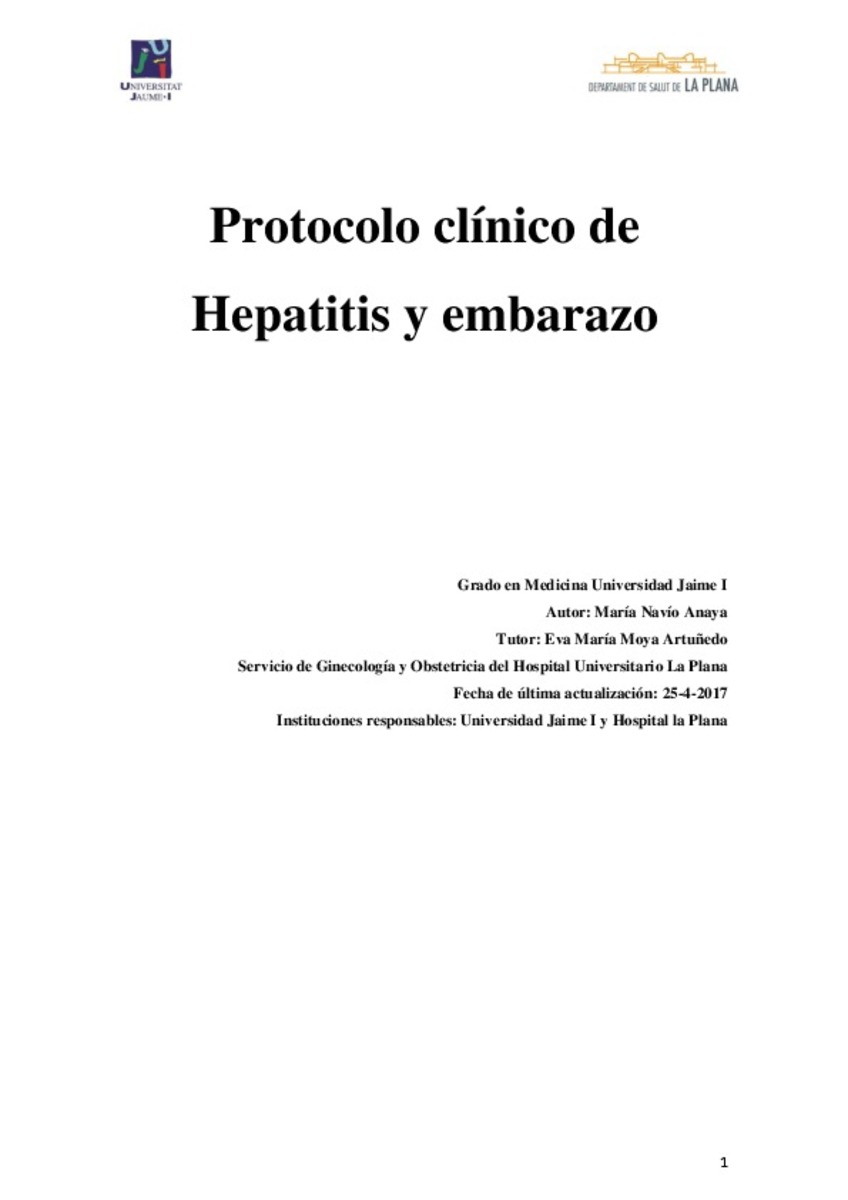Mostrar el registro sencillo del ítem
Protocolo clínico de hepatitis y embarazo
| dc.contributor | Moya Artuñedo, Eva María | |
| dc.contributor.author | Navío Anaya, María | |
| dc.contributor.other | Universitat Jaume I. Unitat Predepartamental de Medicina | |
| dc.date.accessioned | 2017-05-22T10:22:45Z | |
| dc.date.available | 2017-05-22T10:22:45Z | |
| dc.date.issued | 2017-05-03 | |
| dc.identifier.uri | http://hdl.handle.net/10234/167598 | |
| dc.description | Treball Final de Grau en Grau en Medicina. Codi: MD1158. Curs: 2016/2017 | ca_CA |
| dc.description.abstract | Las hepatitis virales representan el 33% de la enfermedad hepática en la mujer embarazada. Los programas de screening materno y la vacunación universal en los lactantes han reducido significativamente las tasas de transmisión materno-fetal. En nuestro país las hepatitis más frecuentes son: hepatitis B (VHB), con una prevalencia de 1/1000 en la gestante y hepatitis C (VHC), inferior al 3% en la población general. Aunque no tenemos un tratamiento específico, es importante el estricto control del embarazo para prevenir, reducir y controlar la posible infección neonatal. El presente trabajo, ha consistido en la realización de un protocolo asistencial adaptado a nuestro entorno. Este protocolo se establecerá en el Hospital Universitario de la Plana. El objetivo de este trabajo, es crear un screening estandarizado y sistematizado, que permita evitar los efectos perjudiciales sobre la madre y el recién nacido. Otros aspectos importantes discutidos en dicho protocolo son la evidencia en el uso de cesárea electiva versus parto vaginal y la posibilidad de la lactancia materna, así como el tipo de fármaco antiviral a utilizar teniendo en cuenta su eficacia y potencial efecto teratogénico. Para elaborar el protocolo, se ha realizado una búsqueda sistematizada para obtener las mejores evidencias científicas del tema. | ca_CA |
| dc.description.abstract | Viral hepatitis accounts for 33% of liver disease in pregnant women. Maternal screening programs and universal vaccination of infants have led to significant reductions in the rate of mother-to-child transmission. In our country, the most common types of hepatitis are: hepatitis B virus (HBV) where prevalence of infection is 1/1000 among pregnant women and hepatitis C virus (HCV), which affects less than 3% of the general population. Although we do not have standardized treatment protocols, regular monitoring throughout the various stages of pregnancy is important in the prevention and management of neonatal infections. Thus, the present work has focused on the realization process of a complete assistance protocol that can be adapted to our environment. This treatment protocol will be established in the University Hospital of La Plana. The objective of this work is to create a standardized and systematic screening procedure that will allow us to prevent prejudicial impacts on mothers and newborns. Some of the other important aspects that are discussed here include the effects of elective caesarean section vs. vaginal delivery on breastfeeding initiation, in accordance with the information that is available. Additionally, the type of antiviral drug that should be used based on its efficacy and potential teratogenic effect. | ca_CA |
| dc.format.mimetype | application/pdf | ca_CA |
| dc.language.iso | spa | ca_CA |
| dc.publisher | Universitat Jaume I | ca_CA |
| dc.rights | Atribución-NoComercial-CompartirIgual 4.0 España | * |
| dc.rights.uri | http://creativecommons.org/licenses/by-nc-sa/4.0/ | * |
| dc.subject | Grau en Medicina | ca_CA |
| dc.subject | Grado en Medicina | ca_CA |
| dc.subject | Bachelor's Degree in Medicine | ca_CA |
| dc.subject | Hepatitis | ca_CA |
| dc.subject | Embarazo | ca_CA |
| dc.subject | Antivirales | ca_CA |
| dc.subject | Lactancia materna | ca_CA |
| dc.subject | Protocolo clínico | ca_CA |
| dc.subject.lcsh | Pregnancy | ca_CA |
| dc.subject.lcsh | Antiviral agents | ca_CA |
| dc.subject.lcsh | Breastfeeding | ca_CA |
| dc.subject.lcsh | Medical protocols | ca_CA |
| dc.title | Protocolo clínico de hepatitis y embarazo | ca_CA |
| dc.type | info:eu-repo/semantics/bachelorThesis | ca_CA |
| dc.educationLevel | Estudios de Grado | ca_CA |
| dc.rights.accessRights | info:eu-repo/semantics/openAccess | ca_CA |
Ficheros en el ítem
Este ítem aparece en la(s) siguiente(s) colección(ones)
-
Grau en Medicina [494]
MD1158








